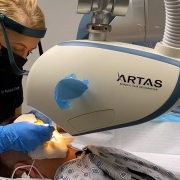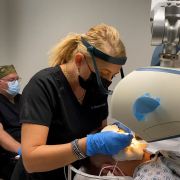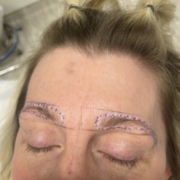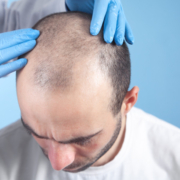Hair Transplant Timeline: Growth, Recovery & What to Expect
Hair transplantation has emerged as a beacon of hope for those experiencing hair loss, offering a chance to regain not just hair but also confidence and self-esteem. This surgical procedure, involving the transfer of hair follicles from one part of the head to another, promises a permanent solution to hair loss.
However, the journey from the decision to undergo a hair transplant to the full fruition of its results is a path paved with patience, care, and understanding of the process.
In this article, we’ll navigate through the hair transplant timeline, detailing each stage from immediate recovery to the emergence of full, healthy hair growth, and set realistic expectations for those considering or having undergone the procedure.
What is a Hair Transplant?
Definition and Purpose:
-
-
- Hair transplantation is a surgical technique for moving hair follicles from a “donor site” to a “recipient site” that is balding.
- It’s primarily used to treat male pattern baldness but also applies to restoring eyelashes, eyebrows, beard hair, chest hair, and filling in scars.
-
Techniques:
- Follicular Unit Transplantation (FUT):
-
-
-
- Involves removing a strip of skin with hair follicles from the donor area.
- The strip is then divided into individual grafts for transplantation.
-
-
- Follicular Unit Extraction (FUE):
-
-
-
- Involves the direct extraction of individual hair follicles from the scalp.
- Extracted follicles are then implanted into the balding areas.
-
-
Considerations:
-
- Each technique has its own set of advantages and considerations.
- Scarring: FUT may leave a linear scar in the donor area, whereas FUE leaves tiny, dot-like scars.
- Recovery Time: Recovery time can vary between the two techniques, with FUE generally offering a quicker recovery due to less invasiveness.
- Naturalness of Outcome: Both techniques aim to achieve a natural-looking hairline, but the choice of technique can affect the final appearance.
Immediate Post-Procedure Recovery
-
First 24 Hours Post-Procedure:
-
-
- Expect swelling, redness, and discomfort around treated areas.
- Crucial to follow the surgeon’s post-operative care instructions to minimize complications and ensure optimal healing.
-
-
First Week Considerations:
-
-
- The scalp may feel tender; some patients might need to wear bandages over the transplantation site.
- Medications may be prescribed, including pain relievers, antibiotics (to prevent infection), and anti-inflammatory drugs (to reduce swelling).
- Advised to avoid strenuous activities and direct sunlight exposure.
- Recommended to sleep with the head elevated to help reduce swelling.
-
-
Scabbing Process:
-
- Begins in the first week around the transplanted hair.
- Scabs protect the newly transplanted follicles and start to fall off as healing progresses.
- Important not to pick at scabs to avoid damaging hair follicles.
Short-Term Recovery Phase (1-3 months)
This phase spans from the first to third-month post-transplant, marking the transition from initial healing to the visible emergence of new hair.
Physical Recovery
- Reduction in Surgery Signs: By the end of the first month, redness and swelling significantly decrease.
- Healing of Donor and Recipient Areas: Scabs fall off, making surgical sites less noticeable.
- Shock Loss: Temporary shedding of hair in the transplanted and surrounding areas is common, indicating that new grafts are settling in.
Hair Growth Initiation
- Emergence of New Hair: Around 2-3 months post-transplant, fine and lightly colored new hairs begin to grow, signaling the start of the growth phase.
- Growth Rate: New hairs typically grow at about a half-inch per month, though this rate can vary among individuals.
Emotional and Psychological Aspects
- Emotional Challenges: The initial excitement may diminish due to shock loss and the anticipation of new hair growth.
- Importance of Realistic Expectations: Understanding that this phase is temporary and essential for achieving final results is crucial for emotional well-being.
This short-term recovery phase is a critical period where patients begin to see the first signs of the fruits of their procedure, navigating through physical healing, the start of new hair growth, and the emotional rollercoaster that can come with waiting for visible results. Patience and adherence to post-operative care are key during this time.
Mid-Term Growth Phase (3-6 months)
The mid-term growth phase is a crucial period where the emergence of new hair becomes more apparent, and the overall texture and density of the hair improve significantly.
-
Continuous Hair Growth:
-
-
- New hairs grow continuously from the third to the sixth month.
- These hairs become thicker and darker, starting to closely match the patient’s existing hair.
- This period often marks the first time patients notice significant changes in their appearance, with transplanted hair blending more seamlessly with their natural hair.
-
-
Changes in Hair Appearance:
-
-
- The texture of the new hair might differ initially, appearing curlier or straighter.
- Over time, it usually adjusts to match the patient’s natural hair texture.
- Hair density increases as more follicles enter the growth phase and the existing hairs thicken, enhancing the overall look.
-
-
Patient Experience:
-
- This phase offers reassurance to patients, affirming their decision to undergo the transplant.
- Visible improvements lead to increased satisfaction levels.
- There’s a significant boost in emotional and psychological well-being as patients begin to see the fruits of their patience and investment.
Long-Term Results and Full Recovery (6-12 months)
The long-term results phase, spanning from 6 to 12 months post-procedure, is critical for evaluating the success of a hair transplant. This period allows patients to see the majority of the transplanted hair grow in, providing a clear view of the outcome.
Final Hair Growth and Density
- Culmination of Growth Process: By six to twelve months, the hair transplant process reaches its peak, with transplanted hair achieving final density and length.
- Improved Appearance: The hair and scalp’s appearance significantly improves, with any initial texture differences normalizing. The hairline and previously balding areas are now populated with natural-looking hair.
Maintaining Hair Health
- Healthy Lifestyle and Care Regimen: Patients are encouraged to maintain the health and appearance of their transplanted hair through a healthy lifestyle and proper care, including gentle washing, avoiding harsh chemicals, and protecting the scalp from the sun.
- Regular Check-ups: Ongoing consultations with the transplant surgeon are advisable to address any concerns and ensure the transplanted hair’s health.
Emotional and Psychological Impact
- Satisfaction and Confidence Boost: Achieving the final results often brings profound satisfaction, significantly boosting self-esteem, confidence, and overall quality of life.
- Importance of Realistic Expectations: It’s crucial for patients to have realistic expectations from the start and to have openly communicated with their surgeon throughout the recovery process.
Factors Affecting the Hair Transplant Timeline
The hair transplant timeline can vary significantly among individuals due to several factors:
- Individual Differences: Age, health status, and the natural hair growth cycle can influence the speed and quality of recovery and hair growth.
- Post-procedure Care: Adherence to post-operative instructions is crucial for optimal healing and growth. Proper care of the scalp and newly transplanted hair can prevent complications and encourage better results.
- Hair Characteristics: The original density, texture, and color of a patient’s hair can affect the outcome and appearance of the transplant.
Is the Hair Transplant Recovery Process Painful?
The recovery process after a hair transplant involves various sensations but is generally not considered intensely painful. Here’s what you might expect and some tips for managing discomfort:
- Typical Symptoms:
-
- Mild tenderness
- Itchiness
- Redness
- Numbness
- Minor pain
These symptoms are most noticeable in the initial weeks following the procedure. However, they tend to be mild and improve significantly after the first couple of days.
- Managing Discomfort:
-
- Over-the-counter medications: Many patients find relief using anti-inflammatory drugs like aspirin, ibuprofen, or naproxen. These medications can effectively alleviate mild symptoms.
- Follow Doctor’s Post-Op Instructions: Adhering strictly to your surgeon’s post-operative care instructions is crucial. Proper care can not only reduce discomfort but also accelerate the healing process, ensuring your scalp recovers correctly and efficiently.
Conclusion
Navigating the hair transplant timeline requires patience, care, and realistic expectations. From the immediate recovery following the procedure through the various phases of hair growth, understanding what to expect at each stage can make the journey more manageable and fulfilling. By the end of the first year, the rewards of perseverance become evident, with most patients enjoying natural-looking hair growth and a significant boost in confidence. Remember, the key to a successful hair transplant lies not just in the hands of skilled surgeons but also in the patient’s commitment to follow post-operative care instructions and maintain a positive outlook.




 Hair4LifeMed
Hair4LifeMed







